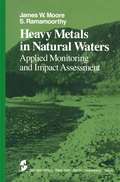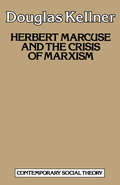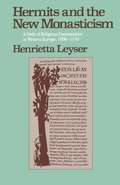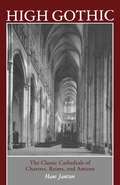- Table View
- List View
Heavy Metals in Natural Waters: Applied Monitoring and Impact Assessment (Springer Series on Environmental Management)
by J.W. Moore S. RamamoorthyThis series is dedicated to serving the growing community of scholars and practitioners concerned with the principles and applications of environ mental management. Each volume is a thorough treatment of a specific topic of importance for proper management practices. A fundamental objective of these books is to help the reader discern and implement man's stewardship of our environment and the world's renewable re sources. For we must strive to understand the relationship between man and nature, act to bring harmony to it, and nurture an environment that is both stable and productive. These objectives have often eluded us because the pursuit of other individual and societal goals has diverted us from a course of living in balance with the environment. At times, therefore, the environmental manager may have to exert restrictive control, which is usually best applied to man, not nature. Attempts to alter or harness nature have often failed or backfired, as exemplified by the results of imprudent use of herbicides, fertilizers, water, and other agents. Each book in this series will shed light on the fundamental and applied aspects of environmental management. It is hoped that each will help solve a practical and serious environmental problem.
Hegel and the Sciences (Boston Studies in the Philosophy and History of Science #64)
by Robert S. Cohen and Marx W. WartofskyTo the scientists and philosophers of our time, Hegel has been either a ne glected or a provocative thinker, a source of irrelevant dark metaphysics or of complex but insightful analysis. His influence upon the work of natural scientists has seemed minimal, in the main; and his stimulus to the nascent sciences of society and to psychology has seemed to be as often an obstacle as an encouragement. Nevertheless his philosophical analysis of knowledge and the knowing process, of concepts and their evolutionary formation, of rationality in its forms and histories, of the stages of empirical awareness and human practice, all set within his endless inquiries into cultural formations from the entire sweep of human experience, must, we believe, be confronted by anyone who wants to understand the scientific consciousness. Indeed, we may wish to situate the changing theories of nature, and of humankind in nature, within a philosophical account of men and women as social practi tioners and as sensing, thinking, feeling centers of privacy; and then we will see the work of Hegel as a major effort to mediate between the purest of epistemological investigations and the most practical of the political and the religious. This book, long delayed to our deep regret, derives from a Symposium on Hegel and the Sciences which was sponsored jointly by the Hegel Society of America and the Boston University Center for Philosophy and History of Science a decade ago.
Hegel, Heidegger, and the Ground of History
by Michael Allen GillespieIn this wide-ranging and thoughtful study, Michael Allen Gillespie explores the philosophical foundation, or ground, of the concept of history. Analyzing the historical conflict between human nature and freedom, he centers his discussion on Hegel and Heidegger but also draws on the pertinent thought of other philosophers whose contributions to the debate is crucial—particularly Rousseau, Kant, and Nietzsche.
Hegel, Heidegger, and the Ground of History
by Michael Allen GillespieIn this wide-ranging and thoughtful study, Michael Allen Gillespie explores the philosophical foundation, or ground, of the concept of history. Analyzing the historical conflict between human nature and freedom, he centers his discussion on Hegel and Heidegger but also draws on the pertinent thought of other philosophers whose contributions to the debate is crucial—particularly Rousseau, Kant, and Nietzsche.
Hegel, Heidegger, and the Ground of History
by Michael Allen GillespieIn this wide-ranging and thoughtful study, Michael Allen Gillespie explores the philosophical foundation, or ground, of the concept of history. Analyzing the historical conflict between human nature and freedom, he centers his discussion on Hegel and Heidegger but also draws on the pertinent thought of other philosophers whose contributions to the debate is crucial—particularly Rousseau, Kant, and Nietzsche.
Hegel, Heidegger, and the Ground of History
by Michael Allen GillespieIn this wide-ranging and thoughtful study, Michael Allen Gillespie explores the philosophical foundation, or ground, of the concept of history. Analyzing the historical conflict between human nature and freedom, he centers his discussion on Hegel and Heidegger but also draws on the pertinent thought of other philosophers whose contributions to the debate is crucial—particularly Rousseau, Kant, and Nietzsche.
The Hellenistic World: Essays And Reflections (The\cambridge Ancient History Ser. #Vol. 7, Pt. 1)
by F. W. WalbankThe vast land empire that Alexander the Great left to his successors was without parallel in Greek history. Alexander’s family and generals created a new order of monarchies and city-states which was to control most of the territory between the Adriatic Sea and western India for three hundred years.
Helping Children Cope With Grief
by Alan WolfeltFirst published in 1984. Routledge is an imprint of Taylor & Francis, an informa company.
Helping Children Cope With Grief
by Alan WolfeltFirst published in 1984. Routledge is an imprint of Taylor & Francis, an informa company.
Hemostatic Mechanisms and Metastasis (Developments in Oncology #22)
by Kenneth V. Honn and Bonnie F. SloaneHepatic Encephalopathy in Chronic Liver Failure
by Livio Capocaccia, Joseph E. Fischer and Filippo Rossi-FanelliThe meeting which took place in Rome on November 19th and 20th of 1982 is easily the best meeting on hepatic coma that I have ever attended, and I have attended many. It was an exceedingly we- planned meeting with prolonged opportunity for discussion, and there was genuine interplay and exchange of ideas (not the usual picture of a rushed meeting with investigators presenting their own point of view and talking past each other without a meaningful ex change) which took place in Rome. My co-editors and I hope that the published transcript, which of course can only reflect what transpired in Rome on those two days, does justice to a very intellectually exciting and gratifying ex change of ideas. L. Capocaccia, J. E. Fischer and F. Rossi-Fanelli v CONTENTS Introduction 1 SECTION 1: PATHOGENETIC PROBLEMS IN HEPATIC ENCEPHALOPATHY Ammonia: The old and the new • • . • • • . • . • • • . • . • 5 L. Zieve Role of synergism in the pathogenesis of hepatic encephalopathy • • • • . • • . . . . • 15 L. Zieve y-Aminobutyric acid receptors in experimental hepatic encephalopathy •. •. • • 25 M. L. Zeneroli, ~. Baraldi,and E. Ventura A possible role for excitatory neurotoxic amino acids in the pathogenesis of hepatic en 41 cephalopathy • • • • • • • • • • • • • • • F. Moroni, G. Lombardi, G. Moneti, D. Pellegrini and C.
Hepatitis B: The Virus, the Disease, and the Vaccine
by Irving Millman Toby K. Eisenstein Baruch S. BlumbergToby K. Eisenstein Symposium Committee Chairperson Temple University School of Medicine Philadelphia, Pennsylvania 19140 This symposium is the thirteenth biennial clinical microbiology program sponsored by the Eastern Pennsylvania Branch of the American Society for Microbiology in cooperation with the Philadelphia area medical schools and the Bureau of Laboratories of the Pennsylvania Department of Health. This year a generous contribution from Merck, Sharp and Dohme has helped to make the program a reality. The subject matter for this symposium represents an attractive spectrum of medical, biological and molecular approaches to the practical solution of a public health prob1em--name1y, prevention of infection with the hepatitis B virus. The symposium may be unique in that it focuses on a product which was first marketed less than three months ago, but included in the program are presen tations on two new approaches to hepatitis B vaccine production which may replace the one which is newly unveiled. The rapidity of progress in our present era of biological research is indeed astonishing.
Hermits and the New Monasticism: A Study of Religious Communities in Western Europe 1000–1150
by Henrietta LeyserThe Herons Handbook (Helm Identification Guides)
by James Hancock James A. KushlanEverything you ever wanted to know about the world's herons.
Herstellung und Versteifungswirkung von geschlossenen Halbrundsicken (IFU - Berichte aus dem Institut für Umformtechnik der Universität Stuttgart #76)
by M. WidmannHerzinsuffizienz (Handbuch der inneren Medizin #9 / 4)
by G. RieckerBearbeitet von zahlreichen Fachwissenschaftlern
Heterotrophic Activity in the Sea (Nato Conference Series #15)
by Peter J. LeB Williams John E. HobbieIntroduction This book contains papers given at a NATO Advanced Research Institute (A.R.I.) held at Caiscais, Portugal, in November, 1981. The subject of the A.R.I. was marine heterotrophy; this is defined as the process by which the carbon autotrophically fixed into organic compounds by photosynthesis is transformed and respired. Obviously all animals and many microbes are heterotrophs but here we will deal only with the microbes. Also, we restricted the A.R.I. primarily to microbial heterotrophy in the water column even though we recognize that a great deal occurs in sediments. Most of the recent advances have, in fact, been made in the water column because it is easier to work in a fluid, apparently uniform medium. The reason for the A.R.I. was the rapid development of this subject over the past few years. Methods and arguments have flourished so it is now time for a review and for a sorting out. We wish to thank the NATO Marine Science Committee for sharing this view, F. Azam, A.-L. Meyer-Reil, L. Pomeroy, C. Lee, and B. Hargrave for organizational help, and H. Lang and S. Semino for valuable editing aid.
High Altitude and Man (Clinical Physiology)
by John B. West Sukhamay LahiriLeading authorities on high-altitude physiology contribute to this work, which is divided into three sections: Man at Extreme Altitude; Sleep and Restoration at High Altitude; and Physiology of Permanent Residents of High Altitude. Based on a symposium on physiology at high altitude sponsored by the American Physiological Society, the volume includes several chapters on the achievements of the 1981 American Medical Research Expedition to Mt. Everest, where the first physiological measurements at altitudes above 8,000 meters were recorded. With growing interest in the study of human performance in these conditions, this text marks a lasting achievement in high-altitude physiology.
High Gothic: The Classic Cathedrals of Chartres, Reims, Amiens
by Hans Jantzen James PalmesThis engaging study introduces the reader to one of the greatest achievements of Western art: the climactic phase of Gothic architecture in the first half of the thirteenth century. Through a comparative analysis of the cathedrals of Chartres, Reims, and Amiens, the author illuminates the technical, theological, artistic, and social factors that formed the High Gothic synthesis. Drawing on a lifetime of scholarship, he successively characterizes the different parts of the Gothic cathedral and describes the human context of the three great buildings.
Histocompatibility Testing 1984: Report on the Ninth International Histocompatibility Workshop and Conference Held in Munich, West Germany, May 6–11, 1984 and in Vienna, Austria, May 13–15, 1984
by E. D. Albert M. P. Baur W. R. MayrHistologie: Lehrbuch der Cytologie, Histologie und mikroskopischen Anatomie des Menschen
by L.C. Junqueira J. CarneiroHistologische Tumorklassifikation: Histopathologische Nomenklatur und Klassifikation der Tumoren und tumorartigen Veränderungen
by G. Breitenecker F. Asboth H. Budka H. Denk W. Feigl H. Hanak J. H. Holzner T. J. Kessler H. Köhler B. Lederer W. Leibl I. Obiditsch-Mayer S. WuketichDie Fortentwicklung der Medizin bringt auch in der Diagnostik der Tumoren und tumorartigen Veränderungen die immer raschere Vermehrung neu er kannter und zum Teil sehr unterschiedlich bezeichneter Entitäten mit sich. Das vorliegende Buch entstand aus dem vielerorts geäußerten Unbehagen der Kli niker und auch der Pathologen über die sogar international unterschiedlichen Nomenklaturen und die damit verbundenen Verständigungs- und Vergleichs schwierigkeiten hinsichtlich der Terminologie. Die vorliegende Klassifika tion erhebt keinen Anspruch auf Vollständigkeit, natürlich auch nicht auf langdauernde Gültigkeit, sondern ist als Nachschlagewerk und Entscheidungs hilfe für eine einheitliche und überregional verwendbare Kategorisierung und Benennung der häufig und der selten auftretenden Tumoren und tumorartigen Veränderungen gedacht. Bernd Lederer, dem damaligen Vorsitzenden der Österreichischen Gesell schaft für Pathologie, gebührt das Verdienst, die Idee zu einem solchen Buch zur Initiative gemacht zu haben und Arbeitsgruppen für die verschiedenen Be reiche zu installieren. Er hat den Abschluß der von ihm in Gang gebrachten Arbeit nicht erlebt. Die Arbeitsgruppen versuchten sich an bereits bestehende Klassifikationen (WHO, ICD-O-DA) zu halten und verwendeten auch anerkannte Monogra phien über einzelne Spezialkapitel. In manchen Fällen wurden Umstellungen vorgenommen oder eigene Vorschläge verwendet, wenn - meist nach unge zählten Sitzungen - Übereinstimmung erzielt werden konnte. In derartigen Fällen wurde die Auflistung der Entitäten durch Erläuterungen ergänzt. Im Glossar wird ein Teil der Kategorisierungsbegriffe definiert.
Historiography and Causation in Psychoanalysis
by Edwin R. Wallace, IVWhat do the psychoanalyst and the historian have in common? This important question has stimulated a lively debate within the psychoanalytic profession in recent years, bearing as it does on the very nature of the psychoanalytic enterprise. Edwin Wallace, a clinician with training in the history and philosophy of science, brings a ranging scholarly perspective to the debate, mediating between rival perspectives and clarifying the issues at stake in the process of offering his own thoughtful conception of the historical nature of psychoanalysis. For Wallace, the procedures, problems, and interpretive possibilities of psychoanalysis and history are strikingly constant and mutually illuminating. He insists, further, that the fundamentally historical nature of psychoanalysis poses no threat to its scientific dignity. In arriving at this verdict, Wallace pushes beyond his expansive treatment of the many parallels between history and psychoanalysis to a systematic consideration of the problem of causation in both disciplines. Tracing the historical background of causation in science, philosophy, history, and analysis, he offers a logical analysis of determinism and a critique of causal language in psychoanalysis while adumbrating the historical character of psychoanalytic explanation. Historiography and Causation in Psychoanalysis is a thought-provoking work that cuts across disciplinary boundaries. It will cultivate the historical sensibilities of all its clinical readers, broadening and deepening the intellectual perspective they bring to the dialogue about the nature of psychoanalytic work. Timely and rewarding reading for analysts, psychiatrists, and clinical psychologists, it will be welcomed by historians and philosophers as well.




















